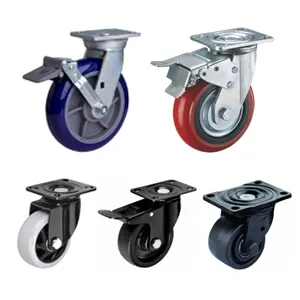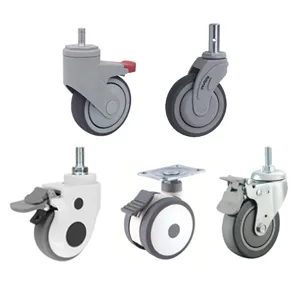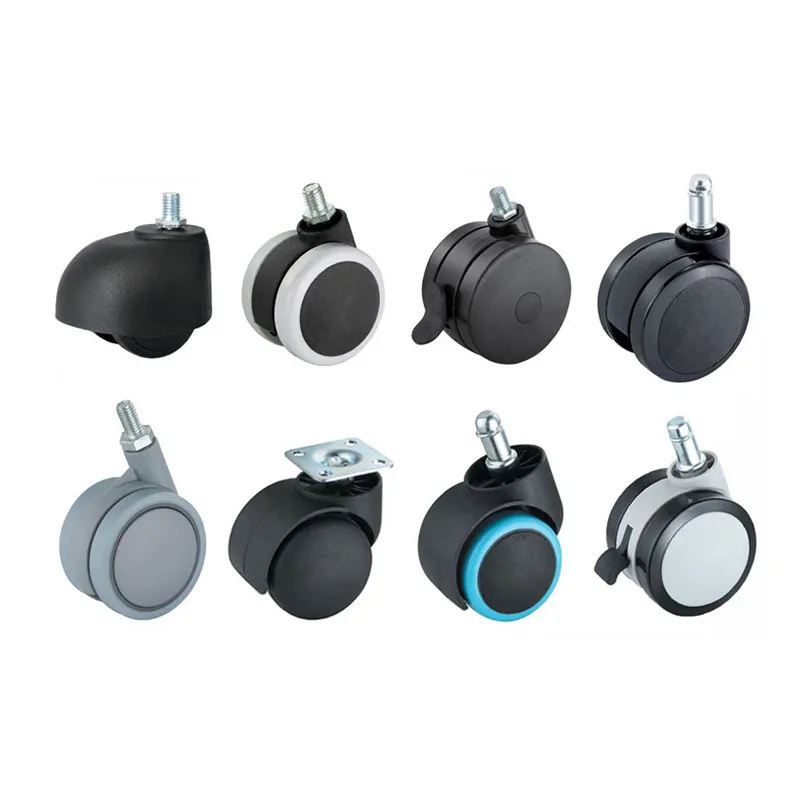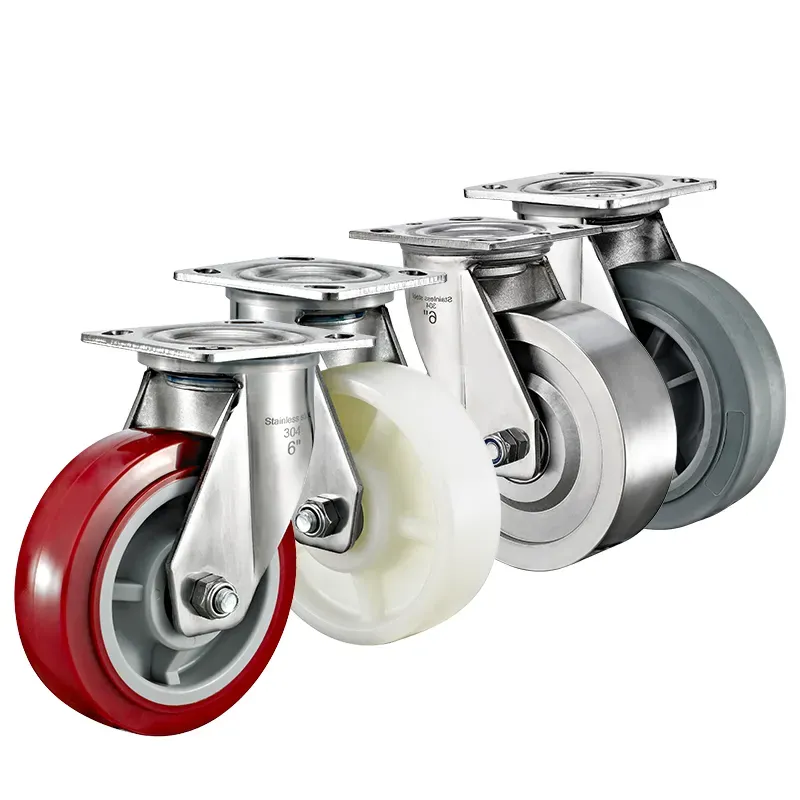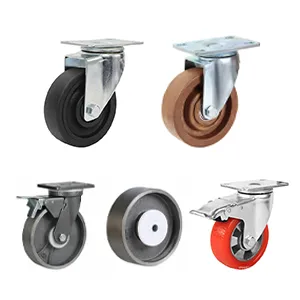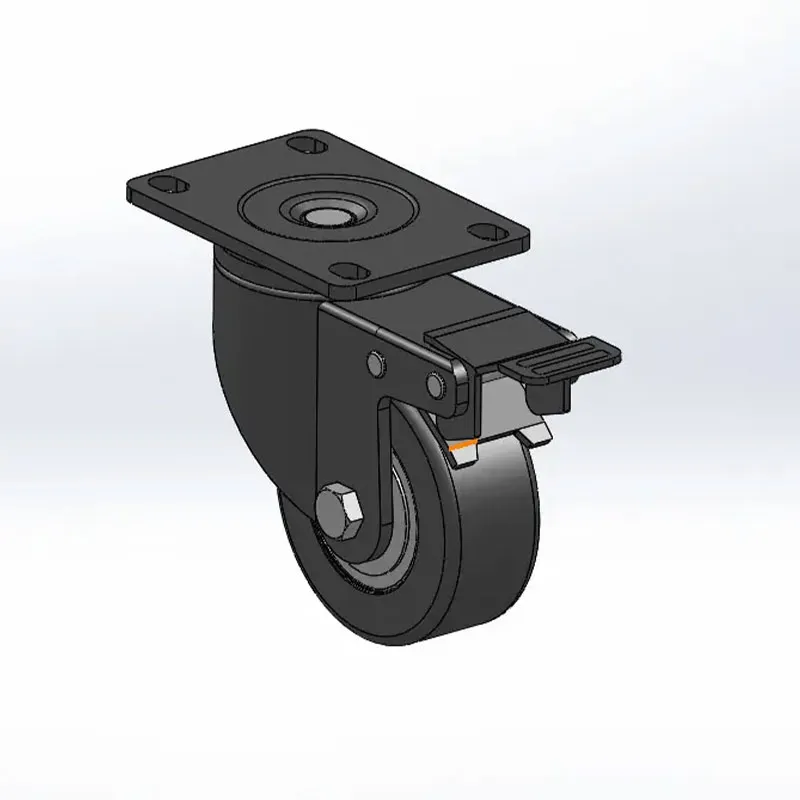Caster Wheel Size Chart
Find Your Perfect Caster Effortlessly!
Welcome to our intuitive Caster Parameter Table. With just a few clicks, discover casters that align precisely with your needs. Our table showcases key features, ensuring you make informed choices quickly and easily. But remember, this is just the tip of the iceberg! We have a vast array of options beyond what’s listed. Craving more details or need a custom solution? Reach out to us! Our team is ready to provide comprehensive parameters and competitive quotes, tailoring solutions perfectly suited for your unique requirements. Let’s roll towards perfection together!
| 1 | Wheel Diameter/ Inch | Wheel Diameter/mm | Wheel Width/mm | Material | Load/kg | Load/lbs |
|---|---|---|---|---|---|---|
| 1,5 | 40 | 40 | ПП | 25 | 55 | |
| 2 | 50 | 47 | ПП | 25 | 55 | |
| 2 | 50 | 38 | ТПР | 38 | 90 | |
| 2 | 50 | 24 | PVC+PU | 40 | 90 | |
| 2.5 | 65 | 30 | PVC+PU | 60 | 130 | |
| 3 | 75 | 58 | ТПР | 58 | 130 | |
| 4 | 100 | 62 | ТПР | 62 | 140 | |
| 2 | 50 | 46 | ПП | 40 | 90 | |
| 2.5 | 65 | 48 | PP+PU | 45 | 100 | |
| 2.5 | 65 | 48 | PP+TPR | 45 | 100 | |
| 3 | 75 | 60 | ПП | 70 | 160 | |
| 3 | 75 | 58 | PP+TPR | 60 | S | |
| 4 | 100 | 70 | PP+TPR | 80 | 180 | |
| 5 | 125 | 80 | PP+TPR | 100 | 220 | |
| 5 | 125 | 32 | PP+TPR | 135 | 300 | |
| 6 | 150 | 50 | ПУ | 450 | 1000 | |
| 8 | 200 | 50 | ПУ | 550 | 1200 | |
| 4 | 100 | 50 | IRON+PU | 300 | 650 | |
| 5 | 125 | 50 | IRON+PU | 350 | 800 | |
| 6 | 150 | 50 | IRON+PU | 450 | 1000 | |
| 8 | 200 | 50 | IRON+PU | 550 | 1200 | |
| 4 | 100 | 50 | ТПР | 300 | 650 | |
| 5 | 125 | 50 | ТПР | 350 | 800 | |
| 6 | 150 | 50 | ТПР | 450 | 1000 | |
| 8 | 200 | 50 | ТПР | 550 | 1200 |
Часто задаваемые вопросы
To learn more about casters, do not hesitate to связаться с нами to get caster solutions and quotes.
Choosing the right castor wheels for your specific needs involves several key steps. Here’s a professional step-by-step guide to help you make an informed decision:
Step 1: Determine the Load Capacity
– **Calculate Total Load**: Assess the total weight of the equipment or furniture that the castors will support. This includes the weight of the object itself plus any additional load it may carry.
– **Divide by Number of Castors**: Divide the total load by the number of castors you plan to use. This gives you the minimum load capacity per castor.
– **Include a Safety Margin**: Always choose castors with a capacity that exceeds your calculated need by at least 25% to 30% to ensure safety and longevity.
Step 2: Assess the Flooring Type
– **Surface Material**: Consider the type of flooring the castors will be used on. Hard castors are generally better for soft surfaces like carpet, while soft castors are preferable for hard surfaces like tile or hardwood to prevent floor damage.
– **Floor Condition**: Take into account any floor conditions like cracks, debris, or uneven surfaces that might affect the castor’s performance.
Step 3: Choose the Wheel Material
– **Polyurethane Wheels**: Great for a variety of surfaces, offer good floor protection, and are durable.
– **Rubber Wheels**: Provide smooth, quiet operation, and good for shock absorption.
– **Nylon or Plastic Wheels**: Suitable for light-duty applications, generally less expensive.
– **Steel or Cast Iron Wheels**: Ideal for high-capacity, industrial applications, especially where floor protection is not a concern.
Step 4: Decide on Wheel Size
– **Larger Wheels**: Roll easier and are better for uneven surfaces or thresholds.
– **Smaller Wheels**: More compact and keep the overall height lower but may be harder to roll on uneven surfaces.
Step 5: Consider the Mounting Options
– **Stem Mounts**: Good for light to medium applications, easy to install.
– **Plate Mounts**: Provide more stability, suitable for heavier loads.
Step 6: Think About Maneuverability
– **Swivel Castors**: Offer full 360-degree movement, great for tight spaces.
– **Fixed/Rigid Castors**: Only move in a straight line, but are more stable for straight-line travel.
Step 7: Evaluate Special Features
– **Brakes or Locks**: Essential for applications where the castor needs to remain stationary at times.
– **Environmental Conditions**: If used outdoors or in harsh environments, consider weather-resistant materials like stainless steel.
Step 8: Compliance and Standards
– Check for any industry-specific standards or compliance requirements, especially in commercial or industrial settings.
Step 9: Consult with a Specialist
– If unsure, seek advice from a castor wheel specialist who can provide tailored recommendations based on your specific requirements.
By following these steps, you can choose castor wheels that are well-suited to your application, ensuring optimal performance, safety, and longevity.
Learn about all types of casters
There are various types of casters available, each designed for specific applications and environments. Understanding the different types can help you choose the right one for your needs. Here are some of the common types of casters:
1. **Swivel Casters**: These casters can rotate 360 degrees, allowing for easy turning and maneuverability in any direction. They are ideal for carts and equipment that require frequent direction changes.
2. **Rigid or Fixed Casters**: These casters do not swivel and only move in a straight line. They are typically used where straight-line motion is needed and are often paired with swivel casters for stability and control.
3. **Braked Casters**: These casters come with a braking mechanism that can lock the wheel in place. They are useful in applications where the equipment needs to stay stationary during use.
4. **Пневматические ролики**: These casters have air-filled tires and provide a cushioned ride, making them suitable for outdoor use or over uneven surfaces. They absorb shocks and vibrations well.
5. **Spring-Loaded Casters**: Designed to absorb shocks and reduce noise, these casters are ideal for equipment that is sensitive to vibration or needs to be transported smoothly over rough surfaces.
6. **Stainless Steel Casters**: These are resistant to corrosion and are often used in environments where cleanliness and hygiene are important, such as in medical or food service applications.
7. **Heavy-Duty Casters**: Built for strength and durability, these casters can support substantial weight and are often used in industrial settings.
8. **V-Groove Casters**: Designed for tracks or floor grooves, these casters guide equipment along a predetermined path, commonly used in industrial or manufacturing environments.
9. **Полиуретановые ролики**: Made with a polyurethane wheel tread, these casters are known for their durability, floor protection, and quiet operation. They are versatile for use in various environments.
10. **Резиновые ролики**: Ideal for protecting floors and reducing noise, rubber casters are commonly used in institutional settings, such as schools and hospitals.
11. **Nylon or Plastic Casters**: Generally more affordable and suitable for light-duty applications. They work well on smooth and hard surfaces.
Each type of caster has its specific advantages and is designed to meet different functional requirements, such as load capacity, floor type, environmental conditions, and maneuverability needs.
Use the online caster load calculator.
Calculating the load capacity for caster wheels is a crucial step in ensuring that the casters you choose can safely and effectively support the weight of your equipment or furniture. Here’s how to calculate it:
1. Determine the Total Weight to be Supported:
– Add the weight of the equipment or furniture that the casters will be attached to.
– Include the maximum load that the equipment or furniture will carry.
2. Decide on the Number of Casters:
– Determine how many casters you will use for the equipment. Common configurations include four or six casters, but this can vary based on design and requirements.
3. Calculate Load Capacity Per Caster:
– Divide the total weight by the number of casters.
For example: If a piece of equipment weighs 400 pounds and will carry an additional 100 pounds, the total weight is 500 pounds. If you plan to use four casters, then each caster needs to support at least 125 pounds (500 pounds ÷ 4 casters).
4. Include a Safety Margin:
– It’s important to add a safety margin to your calculations. A common practice is to add about 25-30% to the load capacity per caster. This accounts for any uneven distribution of weight and unexpected loads.
– Continuing the example, if each caster needs to support 125 pounds, adding a 30% safety margin would mean choosing casters that can each support at least 162.5 pounds (125 pounds × 1.30).
5. Consider the Operating Conditions:
– If the casters will be used in challenging conditions (like rough surfaces, frequent movement, or exposure to chemicals), you may need casters with a higher load capacity.
6. Select Casters Based on Calculated Load Capacity:
– Choose casters that meet or exceed the calculated load capacity per caster, including the safety margin.
By carefully calculating the load capacity and considering the safety margin and operating conditions, you can ensure that your casters will be both safe and effective for your specific needs.

